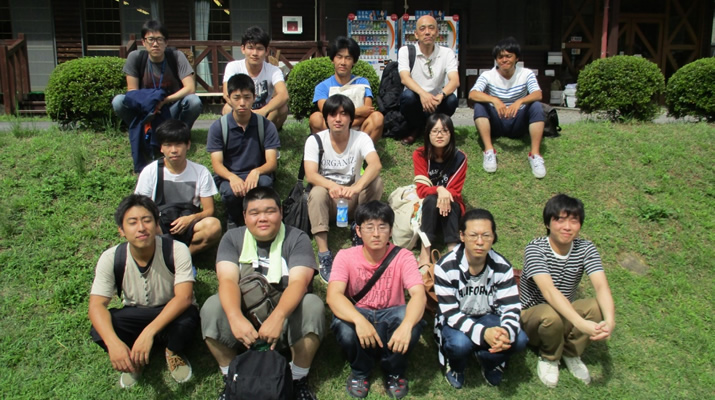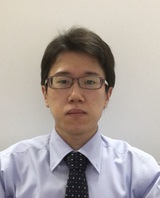
ここからコンテンツです。

New Ultrasonic Wave Phenomenon leads to Improved Safety for Society
Nondestructive testing for earlier assessment of damage to structures By Yosuke Ishii
A research group led by Assistant Professor Yosuke Ishii at Toyohashi University of Technology has unraveled the phenomenon of a new “third ultrasonic wave” being generated when two ultrasonic waves intersect within a plate. This wave exhibits varying intensity in response to material damage and can therefore be used for nondestructively testing thin plate structures. This new technology surpasses conventional technology, enabling precise and nondestructive detection of fatigue and early damage.
Humans are unable to see the inside of an object with the naked eye unless that object is transparent. Using ultrasonic waves, however, can afford us that ability. Ultrasonic waves reflect any defects present within a material. Therefore, measuring these waves reflected from defects can tell us if a material is damaged in any way. In other words, we can “examine” materials without having to break them open. This is the principle behind nondestructive testing using ultrasonic waves. We need nondestructive testing to improve our safety in various situations, so methods for increasing testing accuracy are currently being studied around the world.
Currently, testing the state of a material that is not damaged but has some wear is a particularly hot topic of research in the field of nondestructive testing. In particular the current focus is on testing for fatigue. Like humans, materials also become fatigued. Even a small amount of load is enough to cause material fatigue when repeatedly applied. Fatigue creates minute amounts of damage in a material, which then become bigger and eventually cause the material to break. Thin plate materials are widely used in large-scale structures such as power plants built during Japan’s period of high economic growth after World War II. Now that these structures are aging, it is imperative to use nondestructive methods to test their degree of fatigue. With current technology, we are unable to detect damage unless a large amount of damage (damage that can reflect ultrasonic waves) has already occurred in materials. Because of this, it is of paramount importance to establish a technology that can accurately evaluate material fatigue in its early stages, in fact, the earlier the better.
With this in mind, the research group turned its attention to “three-wave interaction.” This is a phenomenon whereby two intersecting ultrasonic waves produce a third small ultrasonic wave within a plate. Through conducting numerical simulations and theoretical calculations, the research group succeeded in uncovering the mechanism behind how this third ultrasonic wave is generated by a three-wave interaction. The third ultrasonic wave contains a large amount of information of the properties of a material, potentially making it possible to accurately test the early stages of material fatigue (before a large amount of damage occurs).
The research team aims to experimentally verify this new technology to create a new nondestructive testing method for thin plate materials which employs three-wave interaction. Establishing such a technology will make it possible to accurately evaluate material damage far beyond the range of existing technology. This new technology is expected to improve the safety and reliability of socially important structures such as power generation plants and airplanes, and ultimately, to contribute to the safety of all of us.
This work was supported by JSPS KAKENHI Grant No. JP17K14557.
Reference
Y. Ishii, K. Hiraoka, and T. Adachi, “Finite-element analysis of non-collinear mixing of two lowest-order antisymmetric Rayleigh–Lamb waves,” Journal of the Acoustical Society of America Vol. 144, No. 1 (2018) pp. 53–68.
https://doi.org/10.1121/1.5044422.
超音波の新現象が社会の安全性向上につながる
構造物の損傷をより早い段階で非破壊的に評価可能にBy 石井 陽介
豊橋技術科学大学機械工学系の石井陽介助教らの研究グループは、「板の中で二つの超音波を交差させたときに新しい三つ目の超音波が発生する現象」を初めて解明しました。この「三つ目の超音波」の強さは、材料の損傷状態に対して極めて敏感に変化するため、飛行機や発電所といった薄板構造物の非破壊損傷評価への応用が期待されています。特に、従来の技術では検出が難しいとされる材料疲労や損傷の初期段階などを高感度に非破壊検出できる可能性を秘めています。
私たちは、材料が透明でない限りその内部を直接目で見ることができません。しかし超音波を使えば、見えないものも見えるようになります。もし材料内部に傷があれば、そこで超音波が反射します。そのため、傷からの反射波を測定することで、我々は傷の存在を認識することができます。つまり、材料を壊さずに内部を「診る」ことができるのです。これが超音波を用いた非破壊評価の基本原理です。非破壊評価は我々人類の安全を守るうえで必要不可欠な技術であり、評価精度のさらなる向上に向けて今なお世界中で研究がなされています。
現在、非破壊評価の中でも特に問題にされているのが「傷は無いが材料が劣化している状態」の評価です。その代表例として、疲労が挙げられます。人間と同じく材料にも疲労がたまります。たとえ小さな力でもそれを繰り返し受け続けると材料に疲労がたまり、やがて微小な傷が発生します。そして、それが大きな傷へと成長し、最終的に破壊に至ります。高度経済成長期に建設された発電所などの大形構造物には薄板材料が広く使用されており、それらの高経年化に伴う疲労状態の非破壊評価が重要とされています。特に、現在の技術では大きな傷(超音波を反射させる傷)が発生してからでないとそれを検知できないため、微小な傷が発生した段階、さらにはその前段階で疲労状態を精度よく評価できる技術の確立が課題とされています。
そこで、研究グループは超音波の非線形現象である「三波相互作用」に着目しました。これは、板の中で二つの超音波を交差させると三つ目の小さな超音波が発生する現象です。研究グループは数値シミュレーションや理論計算を行い、三波相互作用で生じる三つ目の超音波の発生メカニズムの解明に成功しました。この三つ目の超音波は材料特性の情報を豊富に含むため、この波を測定することで疲労の初期段階(大きな傷が発生する前段階)を感度良く評価できるのでないかと期待されています。
研究チームは、今後実験的検証を行い、最終的に三波相互作用を用いた新しい薄板材料の非破壊評価法を確立したいと考えています。これにより従来は検知できなかった材料のほんのわずかな損傷でさえも感度良く評価できるようになり、発電所や飛行機といった社会的に重要な構造物の安全性・信頼性の向上、つまり社会の安全性向上につながると期待されます。
本研究は、JSPS科研費JP17K14557の助成によって実施されたものです。
Researcher Profile

| Name | Yosuke Ishii |
|---|---|
| Affiliation | Department of Mechanical Engineering |
| Title | Assistant Professor |
| Fields of Research | Solid Mechanics, Mechanics of Nondestructive Testing |
ここでコンテンツ終わりです。
